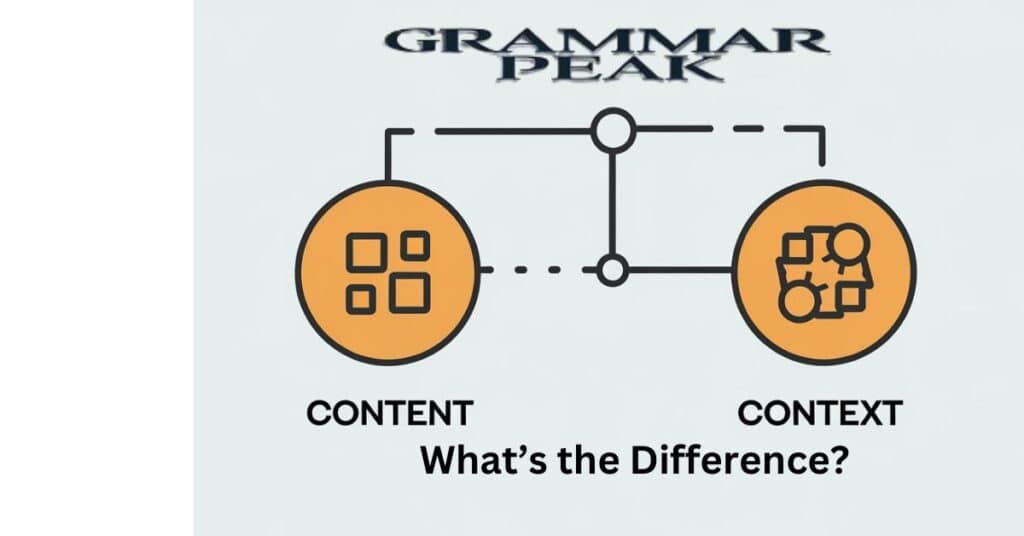When it comes to effective communication, understanding the difference between content vs context is crucial. Specifically, content refers to the information or message being conveyed; whereas, context is the situation or environment in which that message is received.
Both elements play a vital role in how your audience perceives your message. Misunderstanding either can lead to confusion and engagement issues. In this article, we will explore the nuances of content and context, their types, and how they work together for effective communication.
Why is There Confusion?
Many people often mix up content and context.This confusion usually happens because both terms play vital roles in communication. In contrast, while content can exist by itself, it is the context that gives it depth and meaning. For instance, consider a meme. It might seem funny in one culture, but another culture could see it as offensive.
This, therefore, highlights how essential it is, especially for those involved in content creation or digital media, to grasp the difference between the two. Understanding this distinction is crucial. If creators overlook context, they risk miscommunication and might not engage their audience effectively.
Whether it’s a blog post, a social media update, or any form of visual content, recognizing the role of context can, therefore, enhance the impact of the content being shared. Ultimately, a clearer understanding helps in crafting messages that resonate well across different cultural and situational contexts. Moreover, the confusion between content and context can, as a result, lead to significant engagement issues. When content is shared without considering its surrounding context, it may, consequently, not reach the intended audience effectively. This, in turn, can result in miscommunication, where the message is either misunderstood or ignored.
You will like Content vs Context: What’s the Difference?
What is Content?
Content is the information, ideas, or messages you deliver through various formats. It can include text, images, videos, and audio. In the digital age, content comes in many forms. As an example, blog posts, social media updates, and interactive media are all types of content.
The goal is often to inform, entertain, or engage the audience. Nonetheless, the effectiveness of your content depends on how well it resonates with the audience.
Types of Content
There are various types of content available today. Each type serves a different purpose and engages audiences in unique ways. Some common types include:
- Visual Content: Images, infographics, and videos that capture attention quickly.
- Written Content: Articles, blogs, and eBooks that provide in-depth information.
- Interactive Content: Quizzes, polls, and games that encourage audience participation.
Understanding these types helps in tailoring your communication strategy effectively.
How Content Changes Meaning
The meaning of content can shift based on delivery and audience. A joke might be funny to one group; however, it may be inappropriate to another. For instance, a marketing campaign that works in one cultural context, on the other hand, may fail in another.
Therefore, knowing your audience is crucial. Consider how different cultures might interpret language, humor, and references.
What is Context?
Context refers to the circumstances surrounding a piece of content. Cultural, historical, and situational elements influence how a message is received. Context shapes the perception of content. Without context, even the most well-crafted content can lead to miscommunication.
Types of Context
Understanding the types of context is essential for effective messaging. Here are some key contexts you should consider:
- Historical Context: The events and conditions that have influenced a particular topic over time.
- Cultural norms and values shape how people interpret information.
- Situational context refers to the specific circumstances in which people present the content.
Historical Context
- For example, time period refers to the specific era when people created a piece of content. As a result, it can significantly influence its meaning and reception.
- Historical events, for instance, include major occurrences such as wars or social movements. Therefore, they can shape how people understand the content.
- Cultural norms, or the accepted beliefs and practices of a society at a given time, can impact how people interpret content in a historical context.
- Social Changes: Shifts in societal values over time can alter the relevance and interpretation of content created in a different historical context.
- Technological advancements, in fact, involve innovations that occur during a specific time period. Consequently, they can affect how content is produced and consumed.
- Collective Memory: The shared experiences and memories of a society play a crucial role in framing the historical context of any content.
Cultural Context
- Traditions and Customs: The established practices and rituals within a culture can deeply influence how content is created and received.
- Language and Symbols: The unique language, phrases, and.Traditions and customs, for example, include the unique practices, rituals, and behaviors that are deeply ingrained within a particular culture. These can, in turn, significantly impact how content is interpreted. Therefore, understanding these cultural aspects is essential.
- Language and Symbols: The way a culture uses and assigns meaning to specific words, phrases, and visual representations can profoundly influence how content is understood.
- Social Norms: The accepted standards of behavior and etiquette within a culture can shape the way content is perceived and the expectations surrounding its creation and consumption.
- Religious Beliefs: The spiritual and religious beliefs held by a culture can shape the themes, imagery, and underlying messages present in its content.
- Gender Roles: The societal expectations and perceptions surrounding gender within a culture can affect the creation, portrayal, and interpretation of content.
- Generational Differences: The varying perspectives and experiences of different age groups within a culture can lead to diverse interpretations of the same content.
Situational Context
- Location: The physical or virtual space where the content is consumed can greatly impact its relevance and perception.
- Audience: The specific group of individuals engaging with the content plays a crucial role in shaping its message and effectiveness, as their interests and backgrounds can vary widely.
- Purpose: The intended goal behind creating the content—whether to inform, entertain, or persuade—guides its style and delivery, influencing how it is received in different contexts.
- Timing: The moment when the content is shared, consequently, can affect its impact, as current events or trends may enhance or diminish its relevance.
- Medium: The platform or format through which the content is delivered (e.g., social media, print, video), therefore, can determine how it is perceived and engaged with by the audience.
- Emotional State:The feelings and attitudes of the audience at the time of engagement, consequently, can significantly alter their interpretation and reaction to the content.
Social Context
- Group Dynamics: How relationships and interactions among individuals within a group influence the perception and interpretation of content.
- Social Status: The hierarchical position of individuals within a society, therefore, can affect how they engage with content, as those with higher status may have different expectations or access compared to others.
- Interactions: The exchanges and communications between individuals can shape the context in which content is discussed, interpreted, and appreciated within a social setting.
- Cultural Identity: The collective identity of a group, including shared values and beliefs, thus, can influence how content resonates with its members.
- Community Norms: The unwritten rules and expectations that govern behavior within a social group can affect the acceptance and interpretation of certain content.
- Peer Influence: The impact that peers and social circles have on an individual’s response to content can lead to varying interpretations based on collective opinions and attitudes.
How Context Changes Meaning
Context can dramatically change the meaning of content. A seemingly harmless statement can be perceived as offensive depending on the context.
For instance, a marketing slogan might resonate beautifully in one area; however, it could fall flat in another due to differing social norms. Understanding context helps in crafting well-received messages.
Explore these Content vs Context: What’s the Difference?
Content vs Context: The Differences
When we compare content vs context, we see they are different yet interdependent.
Content; serves as the essence of expression in various forms of communication. It encompasses the ideas, narratives, and themes that are shared with an audience; for example, through literature, visual art, or digital media.
Context; is the framework that surrounds and influences the interpretation of information or events. It encompasses various dimensions; specifically, social, cultural, historical, and situational factors that shape how messages are conveyed and understood. Understanding context is crucial, as it provides insight into the values, beliefs, and norms of the audience, allowing for more effective communication.
| Aspect | Content | Context |
| Definition | The information or material presented | The circumstances surrounding the information |
| Focus | What is being communicated | How and why the communication is interpreted |
| Importance | Engages the audience with relevant substance | Provides clarity and depth to the message |
| Examples | Articles, videos, images | Cultural background, situational factors |
| Impact | Captures attention and conveys messages | Shapes understanding and influences reactions |
Balancing Content and Context
Why Content Alone Isn’t Enough
Focusing solely on content can lead to miscommunication. A message can be clear; however, it might not resonate if the context is overlooked.
For example, a well-written blog post may not engage readers; instead, it could fail if it lacks relevance to current events or cultural norms. Always consider the context to ensure the content connects with your audience.
How Content and Context Work Together
Content and context work in tandem to create effective communication. For instance, a compelling story shared in an appropriate setting, consequently, can lead to deeper audience engagement. This synergy enhances understanding and reduces the risk of miscommunication
Examples of Good and Bad Communication.
Good Communication: A nonprofit organization shares a clear and impactful story about the people they help, using compelling visuals and testimonials that resonate with their audience, fostering emotional connection and encouraging community support and involvement.
Bad Communication: A brand launches a promotional campaign during a significant cultural event without considering its sensitivity; as a result, it leads to backlash and alienation of its audience due to perceived insensitivity and lack of awareness.
Tips for Getting It Right
Getting the balance right between content and context is not always easy. Here are some tips to enhance your communication strategy:
Know Your Audience:
- Understand who you are communicating with. Their background, interests, and cultural norms, therefore, will significantly affect how your message is received.
Match Content to Context:
- Blog Posts: Incorporate engaging narratives that provide value and insights.
- Social Media: Share concise updates with eye-catching visuals to encourage interaction.
- Emails: Craft personalized messages with clear calls to action for better engagement.
- Webinars: Deliver informative sessions complemented by interactive Q&A segments.
- Podcasts: Use conversational tones and storytelling to connect with listeners effectively.
Simple Tools and Tips for Better Communication
Content Calendars: Organize your messaging schedule to ensure consistent and timely communication.
Analytics Tools: Track engagement metrics to understand audience preferences and improve future content.
Feedback:Encourage audience input; as a result, it will refine messages and enhance overall communication strategies.
Collaboration Platforms: Facilitate seamless teamwork and idea sharing among team members for cohesive messaging.
Visual Design Tools: Create appealing graphics that enhance your communication and capture attention.
Mistakes to Avoid
There are, however, common pitfalls when focusing on content and context.
Common Issues with Ignoring Context
Miscommunication: Important details may be overlooked, leading to confusion and errors.
Engagement issues, for instance, may arise when audiences feel disconnected or uninterested due to irrelevant content.
Reputation damage, consequently, occurs when brands risk losing credibility due to messages perceived as tone-deaf or insensitive.
Lost Opportunities: Ignoring context can result in missed chances to connect meaningfully with the audience.
Increased Conflict: Misaligned messages can lead to disputes or negative reactions from the audience.
When Focusing Too Much on Content Goes Wrong
Irrelevant Content: Messaging that fails to address audience needs or interests, leading to disengagement.
Lost Opportunities: Valuable insights or trends may be ignored, resulting in missed chances for connection.
Overwhelming Complexity: Content that is overly technical or detailed can alienate the audience.
Lack of Personalization: Generic messaging can make audiences feel undervalued and disconnected.
Diminished Trust: Excessive focus on content without context can erode audience confidence in the brand.
How to Fix Misunderstandings
Clarify Your Message: Use simple language and examples to ensure understanding and reduce confusion.
Adjust Based on Feedback: Actively listen to audience responses and modify your communication accordingly.
Be Flexible: Adapt your approach to fit changing circumstances and audience needs for better alignment.
Follow-up: Reach out to clarify any lingering doubts and reinforce key points for better comprehension.
Encourage Questions: Create an open environment where audiences feel comfortable seeking clarification.
Origins of the Words “Content” and “Context”
Origins of the Word “Content”
The term “content” has its roots in the Latin word “contentus,” which means “contained” or “held.” This etymology reflects the idea of something being held within a boundary, much like how information or media is contained within a format.
Over time, the meaning evolved, especially in the realm of literature and communication, to represent the substance or material that fills a particular medium, such as a book, article, or digital platform. Furthermore, in the digital age, “content” has expanded to encompass a wide array of formats, including text, images, videos, and audio. It has become a critical element in marketing, education, and entertainment, highlighting the importance of quality information in engaging and informing audiences.
Origins of the Word “Context”
Context has a fascinating origin, stemming from the Latin word “contextus,” which means “to weave together.” This etymology reflects the idea of interconnectedness, highlighting how different elements come together to create a fuller understanding.
Over time, the term has evolved, thereby emphasizing the significance of surrounding circumstances and conditions that shape meaning in communication. In contemporary usage, context plays a vital role in interpreting messages accurately. It serves as the backdrop against which information is understood, influencing perceptions and reactions.
FAQ” S
What is the main difference between content and context?
Content is the message itself, while context is the situation surrounding that message.
Why is context important in communication?
Context helps clarify the meaning and relevance of the content, ensuring it resonates with the audience.
How can I improve my communication strategy?
Know your audience and tailor your content to fit their cultural and situational context.
What are some common mistakes to avoid?
Ignoring cultural differences and failing to adapt your message to the situation can lead to miscommunication.
How do I fix misunderstandings in communication?
Clarify your message and
Conclusion
In conclusion, understanding the difference between content vs context is essential for effective communication. Both elements must work together to convey messages clearly and meaningfully. By balancing content with context, you can avoid misunderstandings and ensure your audience engages with your message.

Mason Blake is an experienced blogger with a passion for language and communication. With years of expertise in crafting informative and engaging content, Mason shares valuable insights on grammar and writing. His clear, concise, and reader-friendly approach has earned him a loyal following, helping readers sharpen their language skills and master the art of effective communication.







